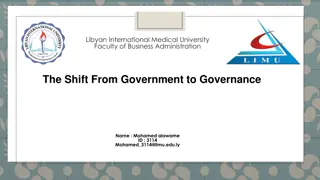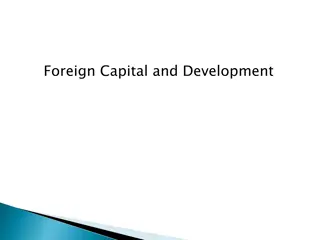Navigating Governance Structures for Specific Investments
This study delves into the role of governance structures in incentivizing specific investments in interfirm relationships. It explores how contractual price terms affect suppliers' motivations to undertake investments, considering factors like haggling and risks of appropriation. The research highlights the importance of governance mechanisms in mitigating contractual hazards and promoting value creation in collaborative settings.
Download Presentation

Please find below an Image/Link to download the presentation.
The content on the website is provided AS IS for your information and personal use only. It may not be sold, licensed, or shared on other websites without obtaining consent from the author.If you encounter any issues during the download, it is possible that the publisher has removed the file from their server.
You are allowed to download the files provided on this website for personal or commercial use, subject to the condition that they are used lawfully. All files are the property of their respective owners.
The content on the website is provided AS IS for your information and personal use only. It may not be sold, licensed, or shared on other websites without obtaining consent from the author.
E N D
Presentation Transcript
Contracting to (dis)incentivize? An integrative transaction-cost approach on how contracts govern specific investments Lo, Zanarone, and Ghosh, SMJ, 2022 BADM549 Youngsir Rha
Research Motive - - What drives value creation in collaborative interfirm relationships? TCE: - Relationship-specific investments drives value creation. - Because investments face contractual hazards, governance structures (contract forms) are needed for safeguarding. - Asset specificity is an exogenous determinant of governance structure How does governance affect the endogenous choice of specific investment? Which governance forms (contracts) encourage/discourage specific investments?
- Closed price: specifies the component s price BEFORE the supplier makes the relationship-specific investment Government Forms: Price Formats - Open price: price can be negotiated after the investment is made
- How contractual price terms affect supplier s incentives to undertake specific investments? - How do the two frictions (haggling and risk of appropriation) jointly shape the direction of such effects? Gap in the Literature Expands literature on TCE, incomplete contracts, and strategic role of resources of the firm
- There is no ex-post haggling and rent-seeking under a closed price contract. Modeling Assumptions - Only consider price formats as a form of governance mechanisms. - Only consider the case where only the supplier makes a specific investment. - Assume a specific bargaining protocol (Tullock model) where the distribution of surplus is equal between the parties.
Timeline Stage 1: Contracting Stage - OEM and supplier agree on a governance (price format) Stage 2: Investment Stage - Supplier chooses a specific investment (bilateral monopoly relationship) - which allows for value creation and appropriation of OEM s resources Stage 3: Adaptation Stage - Supplier can further improve the component Stage 4: Bargaining Stage - In open price format, more exposure to haggling of OEM Stage 5: Appropriation stage - Supplier takes advantage of OEM s pre-existing resources
Contratual Hazards (TCE) 1. Costly haggling 2. Non-contractible adaptation (supplier s specific investment) 3. Risk of appropriation of firm-specific resources that perexist before the relationship How does the specific investment choice of the supplier jointly affect these hazards? - OEM s haggling and supplier s appropriation of preexisting resources What is the optimal choice of contract form when adaptation is important? - Haggling cost held constant, open price format increases specific investment. (But when adaptation is not important, it will decrease specific investment) What if there is risk of appropriation? - Open contracts increase supplier s investment, while closed contracts decrease supplier s investment. Closed contract is the optimal choice.
Closed Price Format Open Price Format Stage 1: Contracting Stage price is specified. price is not specified. Stage 2: Investment Stage Supplier chooses a specific investment to earn the expected payoff= appropriation+half of quasi-rents-haggling cost Supplier chooses a specific investment to appropriate of OEM s resources Stage 3: Adaptation Stage supplier has no incentive to adapt because they will only bear the cost Supplier has incentive to adapt because they will share the value added via adaptation Stage 4: Bargaining Stage no haggling of OEM Price bargain. Haggling loss for both parties Stage 5: Appropriation stage Supplier takes advantage of OEM s pre-existing resources Supplier takes advantage of OEM s pre-existing resources
Proposition 1 There is a critical cutoff, such that under a closed price, supplier s specific investment is higher than under an open price contract when adaptation is unimportant, and lower when adaptation is important. Proposition 2 Under a closed price, supplier s value-added is higher than under an open price when adaptation is unimportant, and lower when adaptation is important.
Optimal Price format: Proposition 3 - - - Which price format maximizes total value creation of the two parties? Depends on the combinations of contracting frictions. When the pre-existing resources is low (appropriation is not important), supplier under-invests due to haggling and appropriation frictions. Therefore, the optimal format is the one that incentivizes supplier s investment. Closed price format when adaptation is unimportant Open price format when adaptation is important When pre-existing resources is high, suppliers over-invest. So the optimal price format is the one that disincentivizes supplier s investment. Closed price format when adaptation is important Open price format when adaptation is unimportant. -
Empirical Design - Survey data on 155 procurement contracts for components between OEMs and supplier in the U.S. - Importance of adaptation: measured by interface complexity. Higher the complexity, higher the need to adapt ex-post. - 7-point Likert scale to measure supplier s specific investment intensity and the value add to OEM s product. - Control variables: - for OEM s bargaining power: the total number of potential suppliers, OEM s relative size, supplier irreplaceability, and component importance - for factors that might affect the choice of price formats: contract enforceability, technological uncertainty, tenure, norm of long-term orientation, norm of flexibility, and controls for alternative governance mechanisms. - Tested for common method variance issue - Uses instrument variables to account for endogeneity of price format (contract enforeability)
1. Closed price format: - when adaptation IS important: disincentivizes investment when adaptation is NOT important: incentivizes investment - Empirical Findings 2. Effect of of adaptation on contract choice (1) is moderated by risk of resource appropriation. - when adaptation IS important: likelihood of choosing a closed price format is increased when the OEM s pre- existing resources have high value
Implications - Which contract form increase or decrease supplier s specific investment depends on the relative importance of haggling and adaptation frictions. - When appropriation risk is included, the conventional governance role of contracts can be reversed. (They can disincentivize specific investment under high importance in adaptation) - Different buyers (OEMs) with different pre-existing resources will seek different governance forms for their relationship with the same supplier. - Paves way for strategic theory of the firm .























